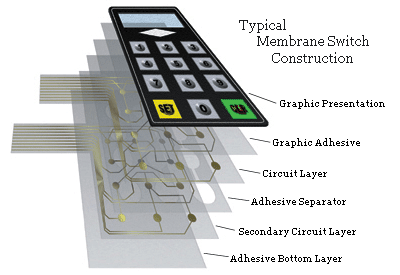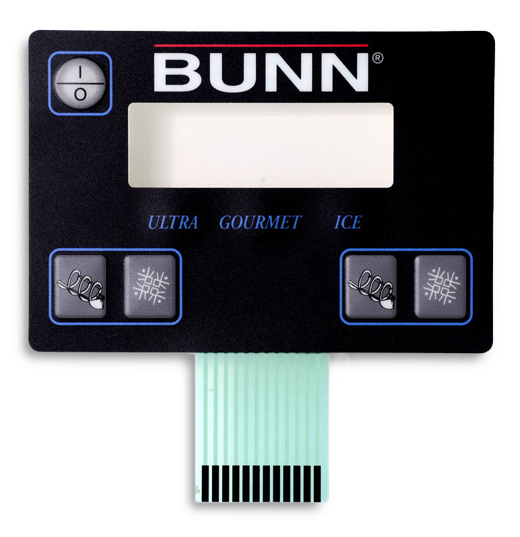Discover How Membrane Switches Feature and Their Duty in Modern Electronics
Membrane Switches represent an innovative combination of innovation and layout within the world of modern-day electronics, offering as crucial interfaces in numerous devices. Comprehending the ins and outs of Membrane button performance and their wider effects in improving customer experience welcomes more expedition right into their layout, advantages, and the innovative developments forming their future in technology.
What Are Membrane Buttons?

Membrane switches are identified by their toughness and resistance to ecological aspects, such as dust, dampness, and extreme temperature levels. They can be customized with numerous graphics, colors, and responsive responses options, enhancing individual experience while maintaining aesthetic charm - membrane switches. Moreover, the unification of published circuits permits seamless assimilation right into tools, enhancing total capability.
The flexibility of Membrane buttons appears in their capability to sustain both easy and intricate control functions. They can include attributes such as LED indicators and touch-sensitive innovation, satisfying particular individual demands. As technology proceeds to develop, Membrane Switches continue to be essential for allowing reliable and user-friendly customer interfaces, consequently playing a pivotal role in the development of modern digital devices.
Parts of Membrane Buttons
Membrane buttons are composed of several crucial elements that interact to produce a practical and trusted user interface. The main aspects consist of the graphic overlay, sticky layer, spacer layer, and conductive traces.
The visuals overlay acts as the customer interface, normally published on an adaptable substrate such as polyester or polycarbonate. This layer not just offers visual appeal but additionally includes responsive responses, aesthetic hints, and safety functions. Underneath the graphic overlay lies the adhesive layer, which safeguards the button to the tool and makes sure sturdiness versus ecological tensions.
The spacer layer is critical for preserving the required void between the visuals overlay and the circuit layer. This void allows for the activation of the button when stress is applied. The conductive traces, usually made from silver or carbon, create the electric pathways that finish the circuit when the switch is engaged.
In addition, a support layer may be consisted of for structural support and insulation. These elements collaborate effortlessly, guaranteeing that Membrane buttons are both durable and straightforward, making them important in different modern-day digital applications.
Just How Membrane Switches Work
Exactly how do Membrane Switches function properly within digital tools? Membrane Switches operate the concepts of pressure-sensitive modern technology, making use of a split construction that consists of graphic overlays, adhesive layers, and conductive elements. When a customer applies stress to the button, the leading layer warps, permitting the conductive aspects beneath to make get in touch with and complete an electrical circuit. This action sets off the wanted feature within the tool.
The design of Membrane switches is crucial for their reliable procedure (membrane switches). The layers are carefully crafted to give tactile feedback, longevity, and resistance to environmental variables such as moisture and dust. The inclusion of domes-- little, elevated areas within the button-- boosts tactile reaction, offering customers with a recognizable click sensation upon activation
Additionally, Membrane buttons can be customized in regards to dimension, form, and graphics, making them appropriate for various applications. They are often made use of in control panels, medical gadgets, and customer electronic devices because of their smooth layout and integrity. Overall, the efficient functioning of Membrane buttons is crucial in enhancing individual interaction and making sure seamless operation in modern electronic tools.

Applications in Modern Devices
Utilizing their distinct style and functionality, you could try here Membrane buttons have click here for info actually become important parts in a large range of modern-day electronic devices. These versatile interfaces are utilized in customer electronic devices, commercial equipment, medical devices, and vehicle controls, giving smooth individual interaction.
In consumer electronic devices, Membrane switches are generally discovered in home appliances like microwaves, cleaning makers, and other family tools, where they make it possible for instinctive control with a sleek profile. Their inconspicuous layout assists in assimilation into small tools, enhancing visual charm without jeopardizing capability.
In commercial applications, Membrane Switches serve as control panels for equipment, using resilience and resistance to severe settings. Their capability to hold up against published here moisture and contaminants makes them excellent for usage in manufacturing and processing industries.
Clinical devices likewise profit from Membrane switches, which are developed to be simple to clean and maintain, guaranteeing hygiene in scientific settings. They are typically made use of in analysis equipment, individual surveillance systems, and mobile clinical gadgets, where reliability is critical.
Advantages of Membrane Switches
One of the essential benefits of Membrane buttons is their adaptability, which allows them to be customized for a selection of applications throughout numerous markets. These switches can be created in numerous sizes and shapes, suiting unique product requirements while providing seamless integration into tools. Their thin account enables a compact and sleek style, typically boosting the aesthetic allure of digital products.
An additional considerable benefit is their longevity - membrane switches. Membrane switches are typically immune to dust, wetness, and chemicals, making them optimal for severe atmospheres. This durability prolongs their life expectancy contrasted to typical mechanical buttons, decreasing the need for frequent substitutes
In addition, Membrane Switches deal cost-effectiveness. The manufacturing process entails printing innovations that lessen manufacturing costs, specifically for huge runs. This price, integrated with low upkeep requirements, makes them an eye-catching option for producers.

Final Thought
In verdict, Membrane Switches represent a substantial advancement in user interface technology within modern electronics. As the demand for instinctive and resilient interfaces proceeds to expand, the function of Membrane buttons in shaping individual experience will definitely expand.
Membrane Switches represent an innovative integration of innovation and layout within the world of contemporary electronic devices, serving as vital interfaces in many gadgets.In the world of contemporary electronic devices, Membrane Switches offer as critical elements that assist in customer interaction with tools. As innovation continues to develop, Membrane Switches stay necessary for enabling user-friendly and efficient user interfaces, therefore playing a pivotal role in the improvement of modern-day electronic tools.
Exactly how do Membrane Switches function efficiently within digital tools? On the whole, the reliable functioning of Membrane buttons is pivotal in enhancing customer communication and making sure seamless operation in contemporary digital devices.
Comments on “Membrane Switches: A Cost-Effective Solution for Product Interfaces”